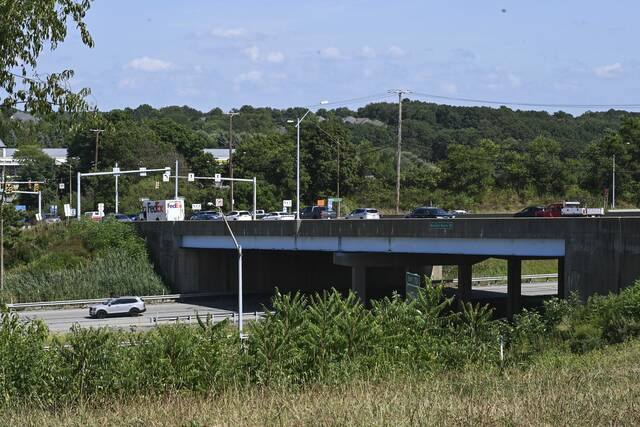Hopes pinned on 'unique' redesign of Wexford I-79 interchange alleviating congestion, reducing crashes
Local officials, business owners and PennDOT are hopeful an investment of nearly $50 million will alleviate congestion and improve safety at the Wexford interchange connecting Interstate 79 with Route 910 in northern Allegheny County.
Work is beginning on a $46.5 million, two-year project that will reconfigure the interchange on the border of Franklin Park and Marshall.
It will see the northbound off-ramp from I-79 to Route 910, the northbound on-ramp from Route 910 to I-79, and the signalized intersection for them on the eastern side of the highway removed.
Replacing those ramps will be two new bridges over the interstate — one south of Route 910 for northbound traffic getting off of I-79 and one north of Route 910 for those getting on and traveling north.
When complete, everything will connect at one intersection on the western side of the Route 910 bridge.
The new interchange will be unique, one of only a few statewide and the first of its kind in PennDOT’s District 11, which covers Allegheny, Beaver and Lawrence counties, said Doug Seeley, assistant district executive for design.
“We’re excited about the project,” he said. “It’s going to make a big improvement for the area. It’s going to be a nice change for the folks that utilize that interchange.”
The Wexford interchange was built in the early 1970s, according to PennDOT.
Traffic on Route 910 between Nicholson and Mingo roads has increased from 17,350 vehicles each day in 2022 to 19,000 in 2024.
From 2017 to 2019, there were 290 total crashes, the majority likely being a direct result of congestion, according to PennDOT.
Seeley said there are times that traffic on the I-79 northbound off-ramp backs up all the way down the ramp to the highway, creating a serious safety concern.
But there are times northbound traffic can be backed up the entire 2 miles from the interchange south to the split of I-79 and I-279, said Eric Voll, vice president of Soergel Orchards.
“It definitely seems year-round there are delays and backups at this exit. We definitely contribute to that on festival weekends and the other businesses and churches here, too,” Voll said. “On our fall weekends, it backs up the entire way to the split of 79 and 279. That’s clearly a very dangerous situation that hopefully the construction will help alleviate any significant backup like that in the future.”
Traffic congestion on Route 910, outside of the interchange project area, prompted Marshall supervisors to include a provision in an update of the township’s land use regulations that allows for townhouses to be built along Route 910 east of Mingo Road. The goal is to reduce the number of driveways and “curb cuts” on the road for the existing single-family homes.
The number of traffic lights near the interchange and the short distances between them causes the congestion, said Tom Madigan, chairman of the Marshall supervisors, who has lived in Marshall since the early 1990s and has been a supervisor since 2000.
“That interchange is a feeder for the entirety of the North Hills, not just Marshall,” he said, noting it also is used by those traveling to and from Pittsburgh on I-279, which he called the biggest contributor to traffic. “All of that traffic is feeding into 910 to 79. All of the development in the North Hills over the last 25 years has contributed to the volume of traffic at that interchange.”
It has taken five to six years to get the point of construction starting, Seeley said.
The reconfigured interchange should improve traffic flow at the interchange, Madigan said.
“It seems to make sense on paper,” he said. “It’s been a long time looking at design options. From the communications we have with PennDOT, the consensus was this was the best option.”
The southern half of the interchange, including the Route 910 bridge over the interstate, is in Franklin Park.
Borough Manager Zachary Filous said they also are hopeful the redesign will make things better.
“As this area’s grown, it’s had difficulty keeping up with the traffic,” he said. “The proposed changes are to help mitigate that traffic backup in that area.”
Daily traffic on Route 910 at the interchange is projected to increase by about 82%, from 19,000 in 2024 to 34,500 in 2045, Seeley said. The new design will be able to handle it, he said.
“Marshall and the surrounding area has been undergoing a lot of development, and it’s probably going to continue,” Madigan said. “It’s a very desirable area. We’ve had a lot of people move in. Whether this accelerates even more development, I don’t know.”
While the land for the removed ramps will remain with the state, Seeley said, no new land is needed for the interchange. That was important for Voll and his family at Soergel Orchards, which lost 13 acres to eminent domain when the interstate was built.
Seeley said several alternatives were considered. Earlier plans would have impacted part of Soergel Orchards’ property, Voll said.
“We were rather nervous initially when we found out there would be another project and did not know what that could possibly mean,” he said. “We were relieved the plan ended up being this way. It looks like a good plan to me.”
Voll said it will be interesting to see how the new interchange works.
“We hope it’s easier for everyone in general, from their daily commute to any day-to-day task,” he said. “The overall positive impact on the local neighborhood, I think, will be welcomed by everyone.”
Brian C. Rittmeyer, a Pittsburgh native and graduate of Penn State University's Schreyer Honors College, has been with the Trib since December 2000. He can be reached at brittmeyer@triblive.com.
Remove the ads from your TribLIVE reading experience but still support the journalists who create the content with TribLIVE Ad-Free.



